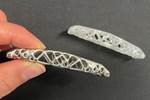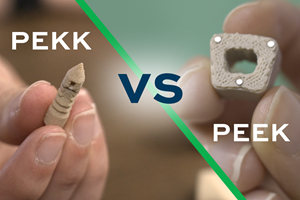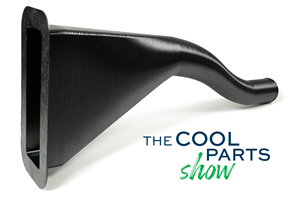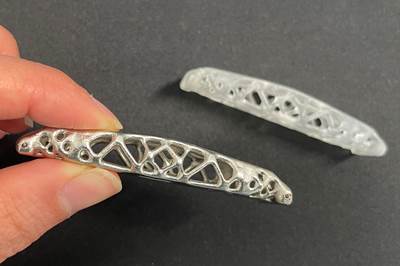Carbon and Hypsole Creating 3D Printed Athletic Guards for Cleats
Designed for athletes across all levels of competition, the guards work like removable outsoles, transforming cleats into functional, sneaker-like footwear that athletes can wear anywhere, and are compatible with a wide range of cleat models and sports.
The adjustable button-and-strap design enables athletes to customize the fit of their guards to accommodate varying cleat heights and widths. Source: Carbon/Hypsole
Specialty sports footwear company Hypsole is launching what it says the first-ever, 3D printed cleat guards using Carbon’s Digital Light Synthesis (DLS) technology. Designed for athletes across all levels of competition, the brand’s first model release, Tidal 3D Elite, is said to offer functionality, convenience, protection and comfort with a sleek look and feel.
The guards work like removable outsoles, transforming cleats into functional footwear that athletes can walk in anywhere. Tidal 3D Elite is compatible with a wide range of cleat models available from major brands for football, soccer, lacrosse, baseball, softball, rugby and ultimate frisbee. The brand was founded by former Division I track and field athlete, Jes Christian, whose college and professional experiences in fashion and sports, eventually led her back to the cleat guard concept.
“Once the functional requirements of the product were established, the aesthetic — from fit to finish —became a top priority. I didn’t want this product to be just another piece of sports equipment. I wanted fashion and streetwear to be infused into the design visuals,” says Jes Christian, Hypsole founder and CEO. “I felt strongly that it needed to look good and that we needed athletes to want it as much as, if not more than, they needed it. Because, at the end of the day, if it works but it’s not hitting aesthetically, then we’re going to be fighting an uphill battle with our target demo.”
Tidal 3D Elite was developed to resemble a sneaker when coupled with an athlete’s cleat through features that help bring the balance of function and fashion to life. The guards were designed to follow the natural curve of common cleat silhouettes, while maintaining a firm grip to keep cleats in place while an athlete is in motion. The adjustable button-and-strap design enables athletes to customize the fit of their guards to accommodate varying cleat heights and widths, while the heel notch gives them a quick and easy way to remove their guards while seated or standing.
The Tidal 3D Elite features a lightweight lattice 3D design with strategic support regions and tough tread for optimal durability. In collaboration with Carbon, Hypsole is manufacturing its first product using DLS — a 3D printing process that uses digital light projection to cure liquid resin, producing products with functional and visual properties that cannot be produced with traditional manufacturing processes.
Over the course of a year, the product’s original design was modified for Carbon DLS. And with input from Carbon’s team, the brand made the decision to leverage Carbon’s Elastomeric Polyurethane (EPU) — a 40% biobased material that rivals the performance of the standard thermoplastic polyurethanes often used in the production of sneaker outsoles — for the entire construction of the athletic cleat guards.
“Carbon’s technology was developed to bring about products that push the boundaries of what’s possible no matter the markets or industry — and Hypsole is no exception,” says Phil DeSimone, Carbon co-founder and office of the CEO. “We’re proud to partner to bring its revolutionary sports footwear concept to life with Carbon’s DLS technology, enabling improved performance for athletes at all levels.”
Tidal 3D Elite comes in two colors (Calcite Hex and Onyx Hex) and 10 unisex sizes. All Hypsole cleat guards run on a custom unisex sizing system, covering a U.S. child’s size 1 up through U.S. men’s and women’s adult sizes.
Related Content
How to Build 10,000+ Shot Molds in Hours
Rapid tooling isn’t so rapid when it takes days to 3D print a metal mold, and then you still must machine it to reach the necessary tolerances. With Nexa3D’s polymer process you can print a mold in hours that is prototype or production ready and can last for more than 10,000 shots.
Read MoreUnderstanding PEKK and PEEK for 3D Printing: The Cool Parts Show Bonus
Both materials offer properties desirable for medical implants, among other applications. In this bonus episode, hear more from Oxford Performance Materials and Curiteva about how these companies are applying PEKK and PEEK, respectively.
Read MoreAircraft Ducts 3D Printed in Composite Instead of Metal: The Cool Parts Show #68
Eaton’s new reinforced PEKK, tailored to aircraft applications, provides a cheaper and faster way to make ducts compared to formed aluminum.
Read MoreDrones Take Flight with Metal and Polymer 3D Printed Parts: The Cool Parts Show Bonus
Drones produced by Cobra Aero now incorporate many 3D printed parts made through laser powder bed fusion and Multi Jet Fusion processes.
Read MoreRead Next
AM Workshop at IMTS: Succeeding With Powder Bed Fusion
A half-day event at the International Manufacturing Technology Show focuses on tactics for success for machine shops and other manufacturers preparing to embrace production 3D printing via powder bed fusion.
Read MoreVideo: Orbit X Pro Football Helmet Uses 3D Printed Lattices
The lightweight helmet from Xenith will be used by NFL and collegiate football players beginning in fall 2024.
Read MorePossibilities From Electroplating 3D Printed Plastic Parts
Adding layers of nickel or copper to 3D printed polymer can impart desired properties such as electrical conductivity, EMI shielding, abrasion resistance and improved strength — approaching and even exceeding 3D printed metal, according to RePliForm.
Read More






















